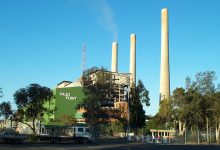Environmental groups have slammed Delta Electricity, the operators of the Vales Point power station, for an almost three-fold increase in particulate pollution.
Greenpeace Australia says that the spike in pollution is putting the respiratory health of NSW residents at risk, a dangerous development considering the presence of the Covid-19 virus.
According to the latest data published on the National Pollutant Inventory, the Vales Point coal fired power station recorded a sharp spike in the release of various pollutants in the 2018-19 financial year.
This included an almost threefold increase in PM2.5 particulate pollution, which can lead to respiratory and heart conditions, as well as increases in other pollutants.
Following the release of the updated pollution data, Delta Electricity issued a statement, confirming that it continued to operate “in accordance with strict environmental licence conditions” enforced by the NSW Environmental Protection Authority.
The company downplayed the significance of the spike in particulate emissions.
“Delta rejects in the strongest terms the statement made by Greenpeace,” a Delta Electricity spokesperson said.
“Delta’s 2018/19 NPI data reports an increase in particulate emissions and associated elements compared to previous years,” Delta Electricity said in the statement. “The results of the stack emissions for 2018/19 are within the normal operating range for the plant and are well within compliance limits.”
“The tests were conducted in March and April of 2019. During this time the diminished performance of a number of filter bags was identified with scheduled bag replacement subsequently occurring.”
Delta went on to suggest that the spike in pollution may be the result of short-term fluctuations in pollution measurements, and a company spokesperson said that this was to expected following the replacement of filter equipment.
“In order to provide information to report to the NSW EPA and the NPI, precise stack gas measurements are taken by independent, suitably qualified contractors, of stack gas emissions over a 4 day period.These results are then extrapolated on an annual basis,” Delta added.
“As a small amount of particulates is being measured in the exhaust gases and then applied to the annual generation quantity, a small year on year variation in emissions will appear exaggerated in the annual reporting numbers.”
The Vales Point power station was acquired from the NSW government by a consortium of private investors, including Trevor St Baker, for just $1 million in 2015.
Despite the power station now being valued in excess of $700 million, to keep the power station operating the new owners have sought additional funding from the government to cover maintenance costs, and is expected to receive as much as $11 million from the federal government to pay for upgrades.
The increase in pollution, however, has been criticised by environmental group Greenpeace, which said the health ramifications of the pollution caused by coal-fired power stations like Vales Point was unacceptable.
“Ageing coal-burning power stations like Vales Point should not be allowed to continue to pump out toxic air pollution that damages the heart and lungs and can lead to asthma and heart attacks,” Greenpeace Australia campaigner Jonathan Moylan said.
“Delta’s admission that the surge in pollution was caused by the failure of critical equipment is particularly disturbing and appears to violate a license requirement to keep the power station well maintained. If Delta is found to have breached its requirements, it should be prosecuted to the fullest extent of the law.”
Greenpeace says the result should serve as a prompt to accelerate the shift to renewable energy sources.
“The dangerous levels of air pollution at Vales Point highlight the urgent need to swiftly replace our coal-burning power stations with clean energy sources like wind and solar and in the meantime, to protect communities with pollution controls which are based on expert medical advice,” Moylan added.
The criticism follows a series of similar claims made last year by the Nature Conservation Council, which launched a court challenge to the operating licence for the Vales Point power station, saying that the Environmental Protection Authority had failed to enforce pollution limits imposed on the power station.
The legal challenge extended to two other NSW coal fired power stations, the Eraring and Mt Piper power stations, owned by Origin Energy and EnergyAustralia respectively.
Delta Electricity also strongly refuted the claims of the Nature Conservation Council.
At 1,320MW and fuelled by black coal, Vales Point power station is also one of Australia’s largest greenhouse gas emitters.
According to updated data published by the Clean Energy Regulator, Vales Point ranked in the top 10 power stations for greenhouse gas emissions, releasing almost 6 million tonnes of carbon dioxide equivalent emissions in the 2018-19 year.
The list highest emitters is topped by AGL Energy’s Victorian brown coal generator Loy Yang A (18.8 million tonnes), Origin Energy’s Eraring power station (15.4 million tonnes) and another AGL power station, the Baywater power station in NSW (14.1 million tonnes).
RenewEconomy and its sister sites One Step Off The Grid and The Driven will continue to publish throughout the Covid-19 crisis, posting good news about technology and project development, and holding government, regulators and business to account. But as the conference market evaporates, and some advertisers pull in their budgets, readers can help by making a voluntary donation here to help ensure we can continue to offer the service free of charge and to as wide an audience as possible. Thankyou for your support.









